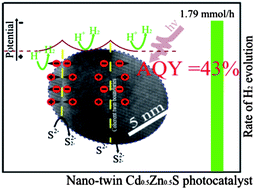Twins in Cd1−xZnxS solid solution: Highly efficient photocatalyst for hydrogen generation from water†
Abstract
Cd1−xZnxS solid solution with nano-twin structures are synthesized and exhibit superior photocatalytic activities for H2 evolution from

* Corresponding authors
a
State Key Laboratory of Multiphase Flow in Power Engineering, Xi'an Jiaotong University, Xi'an, China
E-mail:
lj-guo@mail.xjtu.edu.cn
Fax: +86 29 82669033
Tel: +86 29 82663895
b ARC Centre of Excellence for Functional Materials, The University of Queensland, St Lucia, Australia
c
Queensland Micro- and Nanotechnology Centre, Griffith University, Nathan Campus, Nathan, Australia
E-mail:
x.yao@griffith.edu.au
Cd1−xZnxS solid solution with nano-twin structures are synthesized and exhibit superior photocatalytic activities for H2 evolution from

 Please wait while we load your content...
Something went wrong. Try again?
Please wait while we load your content...
Something went wrong. Try again?
M. Liu, L. Wang, G. (Max) Lu, X. Yao and L. Guo, Energy Environ. Sci., 2011, 4, 1372 DOI: 10.1039/C0EE00604A
To request permission to reproduce material from this article, please go to the Copyright Clearance Center request page.
If you are an author contributing to an RSC publication, you do not need to request permission provided correct acknowledgement is given.
If you are the author of this article, you do not need to request permission to reproduce figures and diagrams provided correct acknowledgement is given. If you want to reproduce the whole article in a third-party publication (excluding your thesis/dissertation for which permission is not required) please go to the Copyright Clearance Center request page.
Read more about how to correctly acknowledge RSC content.
 Fetching data from CrossRef.
Fetching data from CrossRef.
This may take some time to load.
Loading related content
